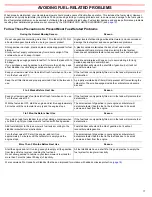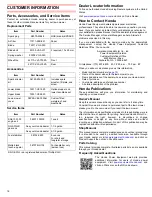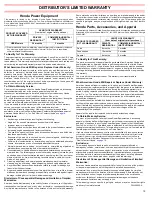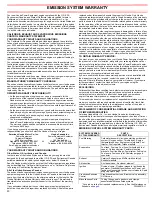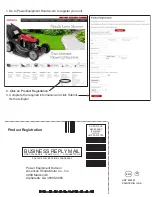
15
TECHNICAL INFORMATION
Serial Number Locations
There are two serial numbers, one for the engine and one for the
mower frame. Record the engine and frame serial numbers in the
space below. You will need these serial numbers when ordering parts
and when making technical or warranty inquiries.
Engine serial number: _________________________________
Frame serial number: __________________________________
Date of purchase: _____________________________________
High Altitude Operation
At high altitudes, the standard carburetor air-fuel mixture will be too
rich. Performance will decrease, and fuel consumption will increase. A
very rich mixture will also foul the spark plug and cause hard starting.
Operation at an altitude that differs from that at which this engine was
certified, for extended periods of time, may increase emissions.
High altitude performance can be improved by specific modifications
to the carburetor. If you always operate your lawn mower at altitudes
above 2,000 feet (610 meters), have your servicing dealer perform
this carburetor modification. This engine, when operated at high
altitude with the carburetor modifications for high altitude use, will
meet each emission standard throughout its useful life.
Even with carburetor modification, engine horsepower will decrease
about 3.5% for each 1,000-foot (300-meter) increase in altitude. The
effect of altitude on horsepower will be greater than this if no
carburetor modification is made.
NOTICE
When the carburetor has been modified for high altitude operation,
the air-fuel mixture will be too lean for low altitude use. Operation at
altitudes below 2,000 feet (610 meters) with a modified carburetor
may cause the engine to overheat and result in serious engine
damage. For use at low altitudes, have your servicing dealer return
the carburetor to original factory specifications.
Emission Control System
Source of Emissions
The combustion process produces carbon monoxide, oxides of
nitrogen, and hydrocarbons. Control of hydrocarbons and oxides of
nitrogen is very important because, under certain conditions, they
react to form photochemical smog when subjected to sunlight. Carbon
monoxide does not react in the same way, but it is toxic.
Honda utilizes appropriate air/fuel ratios and other emissions control
systems to reduce the emissions of carbon monoxide, oxides of
nitrogen, and hydrocarbons. Additionally, Honda fuel systems utilize
components and control technologies to reduce evaporative
emissions.
U.S. and California Clean Air Acts, and Canadian
Environment Protection Act
U.S. EPA, California, and Canadian regulations require all
manufacturers to furnish written instructions describing the operation
and maintenance of emissions control systems.
The following instructions and procedures must be followed in order to
keep the emissions from your Honda engine within the emissions
standards.
Tampering and Altering
NOTICE
Tampering is a violation of federal and California law.
Tampering with or altering the emissions control system may increase
emissions beyond the legal limit. Among those acts that constitute
tampering are:
• Removal or alteration of any part of the intake, fuel, or exhaust
systems
• Altering or defeating the speed-adjusting mechanism to cause the
engine to operate outside its design parameters
Problems That May Affect Emissions
If you are aware of any of the following symptoms, have your engine
inspected and repaired by your servicing dealer.
• Hard starting or stalling after starting
• Rough idle
• Misfiring, backfiring under load, or afterburning
• Black exhaust smoke or high fuel consumption
Replacement Parts
The emissions control systems on your new Honda engine were
designed, built, and certified to conform with EPA and California
emissions regulations. We recommend the use of Honda Genuine
parts whenever you have maintenance done. These original-design
replacement parts are manufactured to the same standards as the
original parts, so you can be confident of their performance. Honda
cannot deny coverage under the emission warranty solely for the use
of non-Honda replacement parts or service performed at a location
other than an authorized Honda dealership; you may use comparable
EPA certified parts, and have service performed at non-Honda
locations. However, the use of replacement parts that are not of the
original design and quality may impair the effectiveness of your
emissions control system.
A manufacturer of an aftermarket part assumes the responsibility that
the part will not adversely affect emissions performance. The
manufacturer or rebuilder of the part must certify that use of the part
will not result in a failure of the engine to comply with emissions
regulations.
Maintenance
As the power equipment engine owner, you are responsible for
completing all required maintenance listed in your owner's manual.
Honda recommends that you retain all receipts covering maintenance
on your power equipment engine, but Honda cannot deny warranty
coverage solely for the lack of receipts or for your failure to ensure
that all scheduled maintenance has been completed.
Follow the
Maintenance Schedule
. Remember this
schedule is based on the assumption that your machine will be used
for its designed purpose. Sustained high-load or high-temperature
operation, or use in unusually wet or dusty conditions, will require
more frequent service.
ENGINE
SERIAL NUMBER
FRAME SERIAL NUMBER
Содержание SHRX217HYA
Страница 21: ...21 NOTES ...
Страница 22: ...22 NOTES ...

















